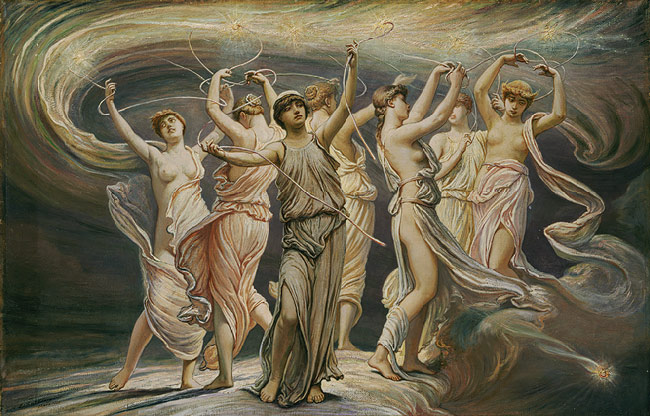
The Pleiades
The Pleiades, companions of Artemis, were the seven daughters of the titan Atlas and the sea-nymph Pleione born on Mount Cyllene in Arcadia, and are sometimes called mountain nymphs, oreads.
They are the sisters of Calypso, a nymph who lived on the island of Ogygia, where she detained Odysseus for several years, the Hesperides, nymphs said to be the daughters of Hesperus, the Evening Star, the planet Venus in the evening, and who tend a blissful garden in a far western corner of the world, Hyas, a notable archer who was killed by his intended prey, and the Hyades, sisters of Hyas who mourned his death with so much vehemence and dedication that they died of grief.
Hesperus is the son of the dawn goddess Eos (Roman Aurora) and is the half-brother of her other son, Phosphorus (also called Eosphorus; the “Morning Star”). Hesperus’ Roman equivalent is Vesper (cf. “evening”, “supper”, “evening star”, “west”). Hesperus’ father was Cephalus, a mortal, while Phosphorus’ was the star god Astraios, the Titan-god of the dusk.
The Hyades, a sisterhood of nymphs that bring rain popularly called “the rainy ones”, but probably from Greek hys, i.e. “swine”, were daughters of Atlas (by either Pleione or Aethra, one of the Oceanides) and sisters of Hyas in most tellings, although one version gives their parents as Hyas and Boeotia.
The main myth concerning them is envisioned to account for their collective name and to provide an etiology for their weepy raininess: Hyas was killed in a hunting accident and the Hyades wept from their grief. They were changed into a cluster of stars, the Hyades, set in the head of Taurus. Their number varies from three in the earliest sources to fifteen in the late ones.
The Greeks believed that the heliacal rising and setting of the Hyades star cluster were always attended with rain, hence the association of the Hyades (sisters of Hyas) and the Hyades (daughters of ocean) with the constellation of the Hyades (rainy ones).
The Hyades are also thought to have been the tutors of Dionysus, in some tellings of the latter’s infancy, and as such are equated with the Nysiads, the nymphs who are also believed to have cared for Dionysus, as well as with other reputed nurses of the god — the Lamides, the Dodonides and the nymphs of Naxos. Some sources relate that they were subject to aging, but Dionysus, to express his gratitude for having raised him, asked Medea to restore their youth.
The Pleiades were nymphs in the train of Artemis, and because they were daughters of Atlas they were together with the seven Hyades called the Atlantides, Dodonides, or Nysiades, nursemaids and teachers to the infant Dionysus, also known as Bacchus, the god of the grape harvest, winemaking and wine, of ritual madness and religious ecstasy in Greek mythology.
Dodona in Epirus in northwestern Greece, was an oracle devoted to a Mother Goddess identified at other sites with Rhea or Gaia, but here called Dione, who was joined and partly supplanted in historical times by the Greek god Zeus.
In Greek Mythology, the Nysiads or Nysiades were Okeanid nymphs of mythical Mount Nysa. Zeus entrusted the infant god Dionysus to their care, and the Nysiads raised him with the assistance of the old satyr-god Seilenos. When Dionysus was grown the Nysiads joined his company as the first of the Bakkhantes, the female followers of Dionysus.
In later tellings of Dionysus’s infancy, the Nysiades appear to be identified with the Hyades. The term might have been used for the Pleiades and the Hyades as Dionysus’s tutors altogether.
After Atlas was forced to carry the heavens on his shoulders, Orion began to pursue all of the Pleiades, and Zeus transformed them first into doves, and then into stars to comfort their father. The constellation of Orion is said to still pursue them across the night sky.
One of the most memorable myths involving the Pleiades is the story of how these sisters literally became stars, their catasterism. According to some versions of the tale, all seven sisters committed suicide because they were so saddened by either the fate of their father, Atlas, or the loss of their siblings, the Hyades.
In turn Zeus, the ruler of the Greek gods, immortalized the sisters by placing them in the sky. There these seven stars formed the star cluster known thereafter as the Pleiades.
The Pleiades would “flee mighty Orion and plunge into the misty deep” as they set in the West, which they would begin to do just before dawn during October–November, a good time of the year to lay up your ship after the fine summer weather and “remember to work the land”; in Mediterranean agriculture autumn is the time to plough and sow.
Although most accounts are uniform as to the number, names, and main myths concerning the Pleiades, the mythological information recorded by a scholiast on Theocritus’ Idylls with reference to Callimachus has nothing in common with the traditional version.
According to it, the Pleiades were daughters of an Amazonian queen; their names were Maia, Coccymo, Glaucia, Protis, Parthenia, Stonychia, and Lampado. They were credited with inventing ritual dances and nighttime festivals.
There is some debate as to the origin of the name Pleiades. Previously, it was accepted that the name is derived from the name of their mother, Pleione. However, the name Pleiades may derive from πλεῖν (to sail) because of their importance in delimiting the sailing season in the Mediterranean Sea.
Filed under: Uncategorized